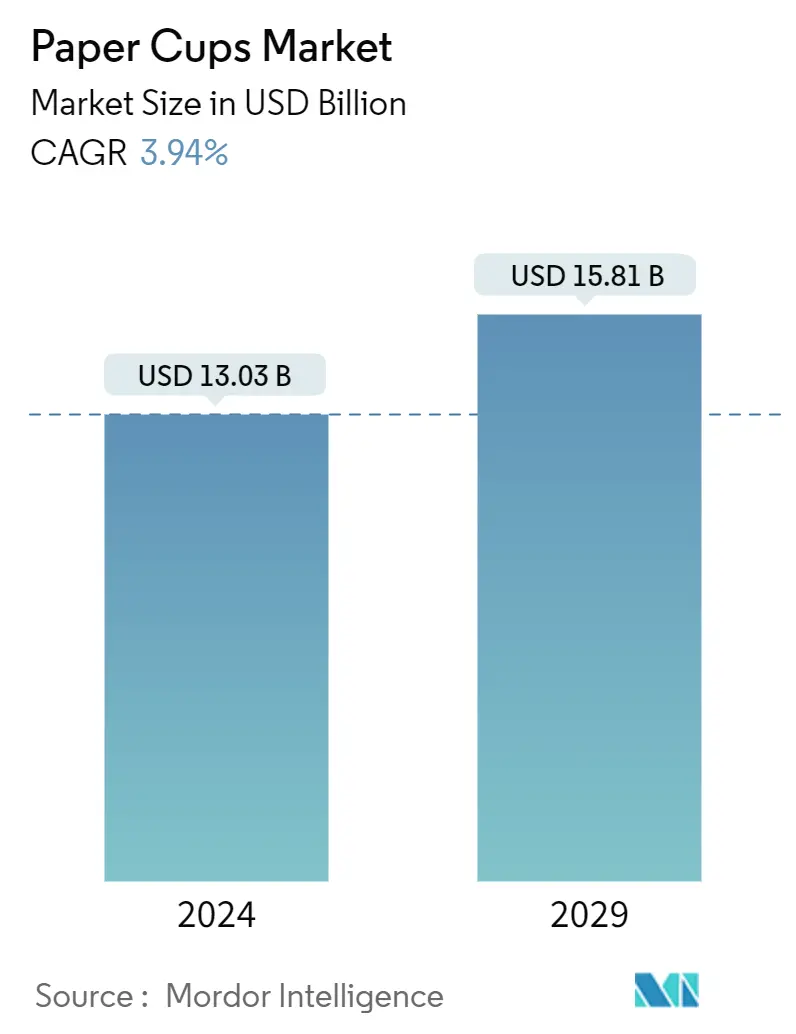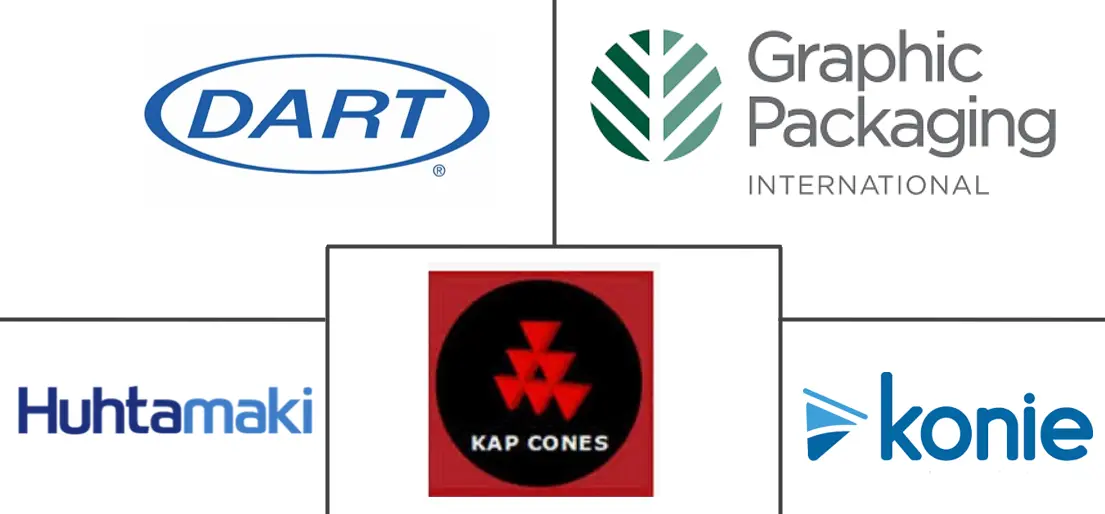Market Size of Paper Cups Industry

| Study Period | 2019 - 2029 |
| Market Size (2024) | USD 13.03 Billion |
| Market Size (2029) | USD 15.81 Billion |
| CAGR (2024 - 2029) | 3.94 % |
| Fastest Growing Market | Asia Pacific |
| Largest Market | Asia Pacific |
Major Players
*Disclaimer: Major Players sorted in no particular order |
Need a report that reflects how COVID-19 has impacted this market and its growth?
Paper Cups Market Analysis
The Paper Cups Market size is estimated at USD 13.03 billion in 2024, and is expected to reach USD 15.81 billion by 2029, growing at a CAGR of 3.94% during the forecast period (2024-2029).
- The beverage industry is expanding worldwide and is expected to contribute significantly to the market for paper cups. As the industry evolves and offers a wide range of beverages, the demand for suitable carriers also increases. The popularity of ordering beverages for takeaway and home delivery grew. This trend further drives the need for paper cups as customers require secure and efficient packaging for transporting their drinks. One of the major factors driving the market growth is the rising demand for paper cups in the increasing trend of consumption of on-the-go beverages. Consumption on the go continuously increased alongside rising urbanization, associated with frenetic habits.
- Further, Starbucks, Dunkin' Donuts, Caribou, and other well-known large coffee shop brands are present in the United States. The market value of the coffee shop in the United States reached USD 45.8 billion in 2022, according to Daily Coffee News.
- Additionally, consumers are looking for a cup that is not only durable but also visually appealing. These qualities make paper cups more desirable and contribute to their high demand. The increase in demand is also due to the rise in beverage consumption. Such factors propel manufacturers to enhance barrier and seal technologies for paper cups and technological breakthroughs for food preservation across the whole supply chain.
- The product's shelf life will be significantly extended by using biodegradable composite materials in paper cup manufacturing and will be utilized by various end users, which will drive the market. A biodegradable kraft, bamboo, or enamel paper board with PE liner makes up the JcFoodpack Bio paper Soup cup. Typical usage includes hot soups, oats, spaghetti, and frozen meals like ice cream or yogurt. In line with the same, players focus on launching innovative solutions to cater to the changing market needs and counter-tightening restrictions.
- In April 2023, WinCup, Inc. created Phade, the first paper cup lined with PHA (polyhydroxyalkanoate). It is a novel new biopolymer produced by the fermentation of canola oil and capable of decomposition in both marine and terrestrial environments, making it possible to use paper cups for hot beverages that are more environmentally friendly. The revolutionary phase paper cup, developed by WinCup, Inc., replaces conventional paper cups. These are coated in plastic made from fossil fuels to contain beverages and are, thus, unable to be recycled or composted.
- However, most paper products, paper cups, cannot be recycled because they are coated in plastic, as little as 5% of each cup. That's why they can hold liquid without spilling it everywhere. It's also why they don't decompose into a pulp and be recycled into paper. Most companies implemented zero waste in their policies. Still, they cannot execute those actions. One of the key contributors to climate change for greenhouse gas emissions emitted by landfills.
- The COVID-19 pandemic heightened hygiene concerns among people, leading to increased demand for disposable plates, cups, and bowls. Individuals became more cautious about sharing personal items, including food and drink containers, to prevent the spread of COVID-19. The production of paper cups faced challenges due to the limited availability of raw materials. Lockdown measures, disruptions in supply chains, and decreased production capacity affected the sourcing of materials necessary for manufacturing paper cups. The shift towards remote work and the closure of offices further impacted the paper cup market. With more people working from home, the demand for takeaway or to-go beverages decreased, affecting the need for paper cups in office settings.
